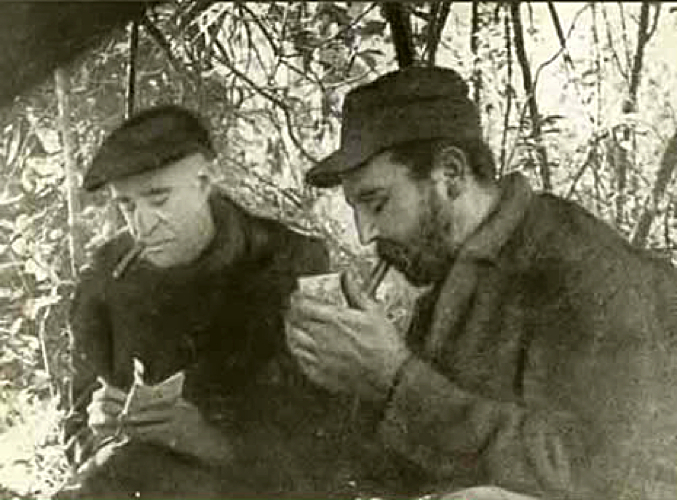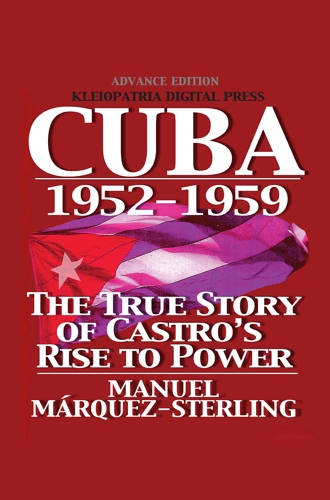February 17, 1957
New York Times journalist Herbert Matthews asked the US Ambassador to Cuba, Arthur Gardner, to make arrangements so he could interview Fidel Castro in his Sierra Maestra camp, which Castro had solicited though Felipe Pazos. Amb. Gardner obliged, making pre-arrangements with Batista to ensure Matthews could travel in safety and without harassment to Castro’s camp.1 Batista himself approved the request.
On February 17 Frank País brought Matthews to the Sierra Maestra for an interview with Castro and the rebels. The interview, including pictures, was published in the Times as a three part series. It proved that Castro was not dead as the Batista government had claimed.
Mathews' report in the Times had an electrifying effect on Cuban public opinion, since he wrote of Castro “He has strong ideas of liberty, democracy, social justice, the need to restore the Constitution, to hold elections." And reported Castro signified a “new democratic deal” for Cuba and was “anti-Communist... Hundreds of highly respected citizens are helping Señor Castro, [who is offering] a new deal for Cuba, radical, democratic and therefore anti-Communist."
Mathews’ report grossly exaggerated the size and strength of rebel forces, increasing Castro's prestige and credibility among Cubans, who began to see and support the Sierra rebels as a viable force to overthrow Batista. On his April 1959 US tour Castro publicly mocked Matthews, telling an audience at the Washington Press Club how he had conned Matthews into thinking he had many more men than he did.
Matthews' egregiously distorted and propagandistic reporting of Castro is the subject of a 2006 book by Anthony DePalma: The man who invented Fidel : Cuba, Castro, and Herbert L. Matthews of The New York Times. A review of that book by Ron Radosh comments on the role Matthews desired and played in Castro’s revolution: A Dictator’s Scribe. Another review of DePalma’s book summarizes key elements of the story that Matthews’ reporting obscured and distorted, and the magnitude of the deception: Fidel’s Favorite Propagandist.
One of the most enduring fictions of Matthews’ reporting is that his travel to the Sierra was a dangerous, frightening trip through jungle, evading government troops. The reality is that having personally approved Matthews’ trip, Batista had to take exceptional measures to ensure Matthews’ safety. It would have been his worst nightmare for Matthews’ to be harmed or killed, for which he would have undoubtedly been blamed. In part for fear that the rebels had planned this, Batista not only ordered that his forces not interfere with Matthews, but also had him shadowed by scouts to protect him from attackers if necessary. As it turned out, Castro wanted him as a propagandist not a casualty to blame on Batista. So for different reasons, both armed camps were vested in Matthews’ safe journey- no reporter ever made a less dangerous trip to a guerilla war zone.
___
Note:
1 Ambassador Gardner testified under oath on August 27, 1960 about making arrangements for the trip at Matthews' request before Senate Hearings. The transcripts of these hearings were published in Communist Threat to the U.S. Through the Caribbean US Senate Committee on the Judiciary hearings, Eighty-Sixth Congress, 2nd session, on Aug. 27, 30, 1960; Part 9. pp675-676. These proceedings are available on the web in multiple formats at the Internet Archive.
 Matthews (left) interviews Fidel Castro in Sierra Maestra, February 1957
Matthews (left) interviews Fidel Castro in Sierra Maestra, February 1957(photo: H.L. Matthews Papers, Rare Book and Manuscript Library, Columbia University)
based on Manuel Márquez-Sterling's Cuba 1952-1959 and
Cuba 1952-1959 Interactive Timeline
Cuba 1952-1959 Interactive Timeline


 Mobile subscription
Mobile subscription



No comments:
Post a Comment